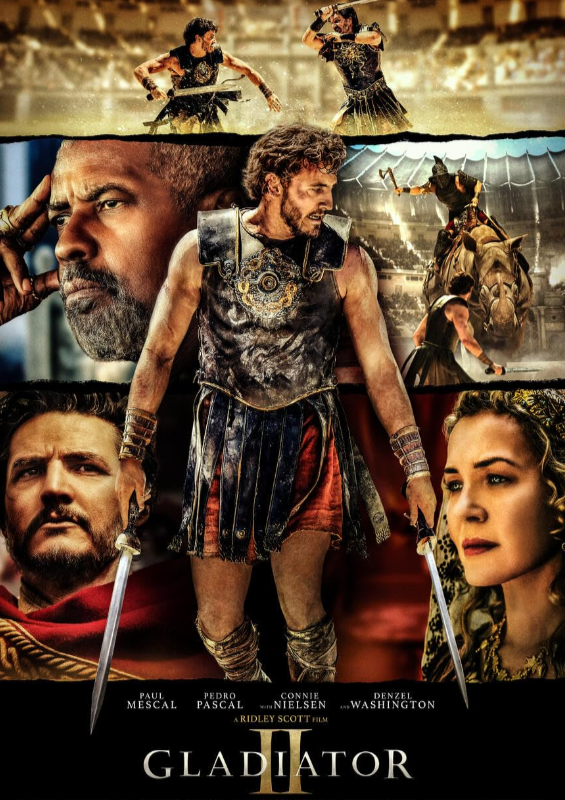The long-anticipated “Gladiator II” released on Friday, 24 years after the release of “Gladiator.” While it doesn’t quite live up to its predecessor, the sequel is sure to entertain those who enjoyed the first film.
The first “Gladiator” begins with the reigning emperor Marcus Aurelius leaving Rome to General Maximus instead of his own son Commodus. When Commodus is informed of this, he murders his father and orders the execution of Maximus and his family. Maximus survives as a captured slave, swearing revenge. After fighting his way through the Colosseum as a gladiator, Maximus eventually gets his revenge by killing the corrupt emperor.
The sequel takes place 16 years after the events of the previous film. Rome is ruled by the cruel twin emperors Geta and Caracalla, played by Joseph Quinn and Fred Hechinger, respectively. While they push for the global expansion of Rome, they are advised to halt their conquest and to feed their people, as overexpansion has stretched their resources thin.
The introduction of these erratic emperors sets up a promising first half of the movie, establishing unpredictable villains while utilizing a new power dynamic to avoid simply mimicking the first film. However, this film’s potential to be unique fades away as soon as the focus shifts to the protagonist.
Lucius, the film’s protagonist, was just a child in the first film. In the sequel, he is a full-grown warrior played by Paul Mescal. While he is not as entertaining nor as sympathetic as Russell Crowe’s protagonist in the first film, perhaps comparison wouldn’t be so necessary if it weren’t for one fatal flaw: His character is written as a carbon copy of Crowe’s.
In both films, the protagonist is a captured warrior who is bought as a slave. He is then forced to fight to the death for a crowd’s amusement, a notion he is against until it becomes his only chance of survival. His warrior skills in the small arena impress his master, earning him a spot to fight as a gladiator in the Colosseum.
In both films, the protagonist has visions of the afterlife where the ones he lost are waiting for him, displaying that while he strives for revenge against those who have wronged him and the good of Rome, he cares most about his loved ones.
In other words, when comparing and contrasting the writing of Mescal’s and Crowe’s characters, the venn diagram is just one circle.
The antagonists carry this sequel on their shoulders. As Lucius battles his way through the Colosseum, we see the captivating dynamic between the two emperors unfold. While the brothers attempt to serve as co-emperors, they have explosive arguments with each other throughout the film.
Geta is like Caracalla in the sense that he is power hungry and cruel towards those who oppose him, but his paranoia results in him being far more cautious than his aloof brother. While they are twins, Geta acts as big brother and primary emperor; as Caracalla sits down and drinks at the Colosseum, Geta speaks publicly at the events and decides who lives or dies. Quinn’s line delivery as Geta sends chills down the spine of the audience, and he steals the film with his unhinged rage.
Just as Marcus Aurelius in the first film was based on a real historical figure, Geta and Caracalla were in fact co-emperors of Rome who had intense disputes when trying to rule together. The dramatic history of the twin emperors had the potential to provide more depth to the characters if it was included in the film, as it would have given Quinn and Hechinger the screen time they deserved.
In addition to the twin emperors, renowned actor Denzel Washington plays the antagonist Macrinus, a wealthy master with political ambitions. After he buys Lucius to be his gladiator, he realizes that Lucius has the ability to cause enough chaos to create a favorable political situation. Washington delivers sinister dialogue about the complicated politics in Rome and how they can be manipulated.
While Washington’s performance is impressive as always, the role itself is given too much importance later in the film, veering off the path the film should’ve stayed on with the twin emperors as the main antagonists.
The first film features extensive plot points and dialogue surrounding the ethical dilemma of the Colosseum and its effect on the Roman people. It explores the timeless idea that entertainment can have a direct effect on politics, as a gladiator gains enough love from the people to stay alive and battle for revenge.
In the sequel, the characters are the focal point, rather than the state of Rome or its overarching themes. This may entertain those desperate to see how the characters reacted to the events of the first film, but not those looking for a complete film with meaning.
“Gladiator II” may not match the quality and depth of the first film, but it is certainly an entertaining experience that should be seen in theaters. After all, a massive screen is only befitting of what Macrinus called “the greatest temple Rome ever built: the Colosseum.”









